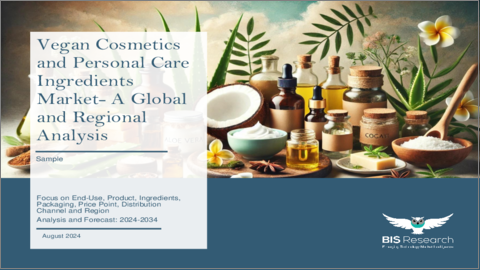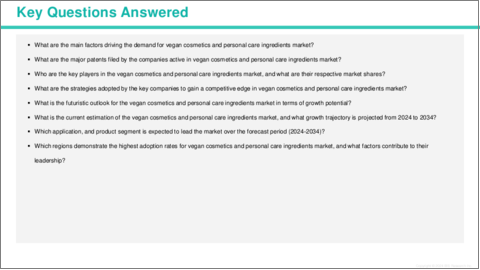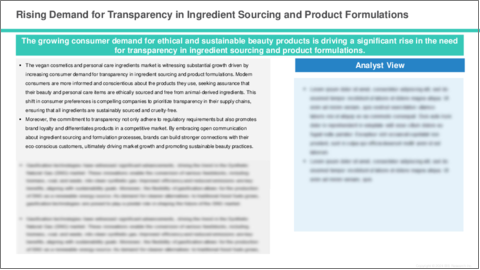|
|
市場調査レポート
商品コード
1545612
ビーガン化粧品とパーソナルケア成分市場- 世界および地域別分析:最終用途別、製品別、成分別、包装別、価格帯別、流通チャネル別、地域別 - 分析と予測(2024年~2034年)Vegan Cosmetics and Personal Care Ingredients Market - A Global and Regional Analysis: Focus on End-Use, Product, Ingredients, Packaging, Price Point, Distribution Channel and Region - Analysis and Forecast, 2024-2034 |
||||||
カスタマイズ可能
|
|||||||
| ビーガン化粧品とパーソナルケア成分市場- 世界および地域別分析:最終用途別、製品別、成分別、包装別、価格帯別、流通チャネル別、地域別 - 分析と予測(2024年~2034年) |
|
出版日: 2024年09月02日
発行: BIS Research
ページ情報: 英文 125 Pages
納期: 1~5営業日
|
全表示
- 概要
- 目次
ビーガン化粧品とパーソナルケア成分の市場規模は、倫理的で持続可能な美容製品に対する需要の高まりに対応する重要な分野として急速に台頭しており、様々な世界市場で牽引力を増しています。
消費者が自分の選択が環境と倫理に与える影響をより意識するようになるにつれ、ビーガン化粧品は動物由来成分を含まないことを保証し、無残で環境に優しい代替手段を提供します。このシフトは、透明性と持続可能性への欲求と相まって、自然で植物由来の処方への認識と嗜好の高まりによって推進されています。楽観的シナリオでは、2024年に109億2,000万米ドルだった同市場はCAGR 7.15%で成長し、2034年には217億9,000万米ドルに達すると予想されます。
動物福祉に対する意識の高まりと、無残な製品を好む消費者の増加が、美容業界におけるビーガン化粧品とパーソナルケア成分の需要を促進しています。アレルギーや皮膚過敏症の発生率が上昇を続ける中、動物由来成分を含まない効果的で安全な製品の必要性が高まっています。ビーガン化粧品とパーソナルケア成分は、品質と効能に妥協することなく天然植物由来の代替品を提供する能力を備えており、スキンケア、ヘアケア、メーキャップなどの用途にわたって不可欠なソリューションとして浮上しています。この市場は、菜食主義者の人口拡大と倫理的消費主義の動向の高まりにより、持続可能で倫理的な美容ソリューションが確保され、大きな成長を遂げています。
| 主要市場統計 | |
|---|---|
| 予測期間 | 2024年~2034年 |
| 2024年の評価 | 109億2,000万米ドル |
| 2034年の予測 | 217億9,000万米ドル |
| CAGR | 7.15% |
ビーガン化粧品とパーソナルケア成分市場では、研究開発コストの高さや、持続可能で効果的な植物由来原料の調達に伴う複雑さなどが課題となっています。さらに、倫理基準を維持しながら製品の安全性と有効性を確保することが、市場参入と拡大にさらなる複雑さをもたらしています。しかし、こうした課題は、化粧品会社、原料供給会社、規制機関の間の革新と協力を促し、より高度なビーガン処方の開発を促進し、美容・パーソナルケア業界における潜在的用途を拡大します。この共同作業は、倫理的消費主義と持続可能な美容ソリューションの成長を支えています。
欧州地域では、スキンケア、ヘアケア、デオドラント剤に含まれるパラベンやアルミニウムなどの化合物の有害性に対する消費者の意識の高まりにより、ナチュラル・オーガニック製品に対する需要が高まっています。多くの消費者が、自然で倫理的な処方のブランドを好むようになっています。英国では近年、化学物質ベースのブランドによる長期的なダメージの可能性に対する意識が高まり、ビーガン美容製品の売上が急増しています。さらに欧州では、消費者の高い意識と倫理的で持続可能な製品に対する強い需要を背景に、英国が欧州のビーガン化粧品とパーソナルケア成分市場をリードしています。自然で無残な処方に重点を置く英国市場は、健康、環境への影響、動物福祉を優先する消費者によって牽引されています。英国ブランドは革新の最前線に立ち、多様な肌色や嗜好に対応する幅広いビーガン化粧品を提供し、業界標準を打ち立てています。
当レポートでは、世界のビーガン化粧品とパーソナルケア成分市場について調査し、市場の概要とともに、最終用途別、製品別、成分別、包装別、価格帯別、流通チャネル別、地域別の動向、および市場に参入する企業のプロファイルなどを提供しています。
目次
エグゼクティブサマリー
第1章 市場:業界の展望
- 動向:現在および将来の影響評価
- サプライチェーンの概要
- R&Dレビュー
- 規制状況
- ステークホルダー分析
- 主要な世界的イベントの影響分析
- 市場力学の概要
第2章 ビーガン化粧品とパーソナルケア成分市場(用途別)
- 用途のセグメンテーション
- 用途の概要
- ビーガン化粧品とパーソナルケア成分市場(最終用途別)
第3章 ビーガン化粧品とパーソナルケア成分市場(製品別)
- 製品セグメンテーション
- 製品概要
- ビーガン化粧品とパーソナルケア成分市場(製品別)
- ビーガン化粧品とパーソナルケア成分市場(成分別)
- ビーガン化粧品とパーソナルケア成分市場(包装別)
- ビーガン化粧品とパーソナルケア成分市場(価格帯別)
- ビーガン化粧品とパーソナルケア成分市場(流通チャネル別)
第4章 ビーガン化粧品とパーソナルケア成分市場(地域別)
- ビーガン化粧品とパーソナルケア成分市場(地域別)
- 北米
- 欧州
- アジア太平洋
- その他の地域
第5章 企業プロファイル
- 今後の見通し
- 地理的評価
- 企業プロファイル
- BASF SE
- Ashland
- Solvay
- Dow
- Clariant
- Croda International Plc
- Evonik Industries AG
- Nouryon
- Lonza
- Kraton Corporation
- The Body Shop International Limited
- L'Oreal S.A.
- Givaudan
- Symrise
- Innospec
- その他の主要企業
第6章 調査手法
Introduction to Vegan Cosmetics and Personal Care Ingredients Market
The vegan cosmetics and personal care ingredients market is rapidly emerging as a vital sector addressing the growing demand for ethical and sustainable beauty products, gaining traction across various global markets. As consumers become more conscious of the environmental and ethical implications of their choices, vegan cosmetics offer a cruelty-free and eco-friendly alternative, ensuring products are free from animal-derived ingredients. This shift is driven by increasing awareness and preference for natural and plant-based formulations, coupled with a desire for transparency and sustainability. In an optimistic scenario, the market, valued at $10.92 billion in 2024, is anticipated to grow at a CAGR of 7.15%, reaching $21.79 billion by 2034.
The rising awareness of animal welfare and increasing consumer preference for cruelty-free products are driving the demand for vegan cosmetics and personal care ingredients in the beauty industry. As incidences of allergies and skin sensitivities continue to rise, there is a growing necessity for effective and safe products that are free from animal-derived components. Vegan cosmetics and personal care ingredients, with their ability to provide natural, plant-based alternatives without compromising on quality and efficacy, have emerged as a vital solution across applications such as skincare, haircare, and makeup. This market is witnessing significant growth due to the expanding vegan population and the growing trend of ethical consumerism, ensuring sustainable and ethical beauty solutions.
| KEY MARKET STATISTICS | |
|---|---|
| Forecast Period | 2024 - 2034 |
| 2024 Evaluation | $10.92 Billion |
| 2034 Forecast | $21.79 Billion |
| CAGR | 7.15% |
In the vegan cosmetics and personal care ingredients market, challenges include high research and development costs and the complexities associated with sourcing sustainable and effective plant-based ingredients. Additionally, ensuring product safety and efficacy while maintaining ethical standards adds further complexity to market entry and expansion. However, these challenges promote innovation and collaboration among cosmetic companies, ingredient suppliers, and regulatory bodies, driving the development of more advanced vegan formulations and expanding their potential applications in the beauty and personal care industry. This collaborative effort supports the growth of ethical consumerism and sustainable beauty solutions.
The Europe region has seen a growing demand for natural and organic products, driven by increased consumer awareness of the harmful effects of compounds such as parabens and aluminum found in skincare, hair care, and deodorants. Many consumers now prefer brands with natural and ethical formulations. Sales of vegan beauty products have surged in the U.K. in recent years, as awareness of the potential long-term damage from chemical-based brands has grown. Additionally, in Europe U.K. leads the vegan cosmetics and personal care ingredients market in Europe, utilizing its high consumer awareness and strong demand for ethical, sustainable products. With a significant emphasis on natural and cruelty-free formulations, the U.K. market is driven by consumers who prioritize health, environmental impact, and animal welfare. British brands are at the forefront of innovation, offering a wide range of vegan cosmetics that cater to diverse skin tones and preferences, thus setting industry standards.
Key Players such as L'Oreal S.A., Lush Retail Ltd., Pacifica Beauty LLC, and CoverFX are at the forefront of market expansion, utilizing their technological expertise and strategic partnerships to drive innovation and capture a significant market share. Companies are investing in the construction of new production facilities and the expansion of existing ones to meet the growing demand. For instance, in May 2021, Unilever, in collaboration with its Hourglass brand, developed a vegan alternative to carmine, a widely used red pigment in cosmetics derived from cochineal insects. This innovation, resulting from three years of research and collaboration with over 30 suppliers, offers a 97% color match to traditional carmine without the need for new synthetic molecules.
Market Segmentation:
Segmentation 1: by End-Use
- Individual Use
- Beauty Salons
- Spa Centers
- Others
Segmentation 2: by Product
- Skincare
- Haircare
- Makeup
- Personal Hygiene
- Fragrances
- Others
Segmentation 3: by Ingredients
- Plant-Based Oils and Butters
- Plant Extracts and Botanical Ingredients
- Vegan Emulsifiers and Stabilizers
- Mineral-Based Ingredients
- Vegan Proteins
- Vegan Preservatives
- Plant-Based Colorants
- Others
Segmentation 4: by Distribution Channel
- Online Retail
- Supermarkets/Hypermarkets
- Specialty Stores
- Pharmacies/Drugstores
- Convenience Stores
- Others
Segmentation 5: by Packaging
- Pumps and Dispensers
- Compact Cases
- Jars
- Pencils and Sticks
- Tubes
- Others
Segmentation 6: by Price Point
- Premium
- Economic
Segmentation 7: by Region
- North America
- Europe
- Asia-Pacific
- Rest-of-the-World
How can this report add value to an organization?
Product/Innovation Strategy: The global vegan cosmetics and personal care ingredients market has been extensively segmented based on various categories, such as ingredients, end-use, product, packaging, price point, and distribution channel. This can help readers get a clear overview of which segments account for the largest share and which ones are well-positioned to grow in the coming years.
Competitive Strategy: A detailed competitive benchmarking of the players operating in the vegan cosmetics and personal care ingredients market has been done to help the reader understand how players stack against each other, presenting a clear market landscape. Additionally, comprehensive competitive strategies such as partnerships, agreements, and collaborations will aid the reader in understanding the untapped revenue pockets in the market.
Key Market Players and Competition Synopsis
The companies that are profiled have been selected based on thorough secondary research, which includes analyzing company coverage, product portfolio, market penetration, and insights gathered from primary experts.
Some of the prominent companies in this market are:
- BASF SE
- The Body Shop International Limited
- L'Oreal S.A.
- Croda International Plc
- Symrise
Key Questions Answered in this Report:
- What are the main factors driving the demand for vegan cosmetics and personal care ingredients market?
- What are the major patents filed by the companies active in vegan cosmetics and personal care ingredients market?
- Who are the key players in the vegan cosmetics and personal care ingredients market, and what are their respective market shares?
- What are the strategies adopted by the key companies to gain a competitive edge in vegan cosmetics and personal care ingredients market?
- What is the futuristic outlook for the vegan cosmetics and personal care ingredients market in terms of growth potential?
- What is the current estimation of the vegan cosmetics and personal care ingredients market, and what growth trajectory is projected from 2024 to 2034?
- Which application, and product segment is expected to lead the market over the forecast period (2024-2034)?
- Which regions demonstrate the highest adoption rates for global vegan cosmetics and personal care ingredients market, and what factors contribute to their leadership?
Table of Contents
Executive Summary
Scope and Definition
Market/Product Definition
Key Questions Answered
Analysis and Forecast Note
1. Markets: Industry Outlook
- 1.1 Trends: Current and Future Impact Assessment
- 1.1.1 Rising Demand for Transparency in Ingredient Sourcing and Product Formulations
- 1.1.2 Increasing Awareness of Ethical and Cruelty-Free Products
- 1.2 Supply Chain Overview
- 1.2.1 Value Chain Analysis
- 1.2.2 Pricing Forecast
- 1.3 R&D Review
- 1.3.1 Patent Filing Trend by Country, by Company
- 1.4 Regulatory Landscape
- 1.5 Stakeholder Analysis
- 1.5.1 Use Case
- 1.5.2 End User and Buying Criteria
- 1.6 Impact Analysis for Key Global Events
- 1.7 Market Dynamics Overview
- 1.7.1 Market Drivers
- 1.7.2 Market Restraints
- 1.7.3 Market Opportunities
2. Vegan Cosmetics and Personal Care Ingredients Market (by Application)
- 2.1 Application Segmentation
- 2.2 Application Summary
- 2.3 Vegan Cosmetics and Personal Care Ingredients Market (by End-Use)
- 2.3.1 Individual Use
- 2.3.2 Beauty Salons
- 2.3.3 Spa Centers
- 2.3.4 Others
3. Vegan Cosmetics and Personal Care Ingredients Market (by Product)
- 3.1 Product Segmentation
- 3.2 Product Summary
- 3.3 Vegan Cosmetics and Personal Care Ingredients Market (by Product)
- 3.3.1 Skincare
- 3.3.2 Haircare
- 3.3.3 Makeup
- 3.3.4 Personal Hygiene
- 3.3.5 Fragrances
- 3.3.6 Others
- 3.4 Vegan Cosmetics and Personal Care Ingredients Market (by Ingredients)
- 3.4.1 Plant-Based Oils and Butters
- 3.4.2 Plant Extracts and Botanical Ingredients
- 3.4.3 Vegan Emulsifiers and Stabilizers
- 3.4.4 Mineral-Based Ingredients
- 3.4.5 Vegan Proteins
- 3.4.6 Vegan Preservatives
- 3.4.7 Plant-Based Colorants
- 3.4.8 Others
- 3.5 Vegan Cosmetics and Personal Care Ingredients Market (by Packaging)
- 3.5.1 Pumps and Dispensers
- 3.5.2 Compact Cases
- 3.5.3 Jars
- 3.5.4 Pencils and Sticks
- 3.5.5 Tubes
- 3.5.6 Others
- 3.6 Vegan Cosmetics and Personal Care Ingredients Market (by Price Point)
- 3.6.1 Premium
- 3.6.2 Economic
- 3.7 Vegan Cosmetics and Personal Care Ingredients Market (by Distribution Channel)
- 3.7.1 Online Retail
- 3.7.2 Supermarkets/Hypermarkets
- 3.7.3 Specialty Stores
- 3.7.4 Pharmacies/Drugstores
- 3.7.5 Convenience Stores
- 3.7.6 Others
4. Vegan Cosmetics and Personal Care Ingredients Market (by Region)
- 4.1 Vegan Cosmetics and Personal Care Ingredients Market (by Region)
- 4.2 North America
- 4.2.1 Regional Overview
- 4.2.2 Driving Factors for Market Growth
- 4.2.3 Factors Challenging the Market
- 4.2.4 Application
- 4.2.5 Product
- 4.2.6 North America Vegan Cosmetics and Personal Care Ingredients Market (by Country)
- 4.2.6.1 U.S.
- 4.2.6.1.1 Market by Application
- 4.2.6.1.2 Market by Product
- 4.2.6.2 Canada
- 4.2.6.2.1 Market by Application
- 4.2.6.2.2 Market by Product
- 4.2.6.3 Mexico
- 4.2.6.3.1 Market by Application
- 4.2.6.3.2 Market by Product
- 4.2.6.1 U.S.
- 4.3 Europe
- 4.3.1 Regional Overview
- 4.3.2 Driving Factors for Market Growth
- 4.3.3 Factors Challenging the Market
- 4.3.4 Application
- 4.3.5 Product
- 4.3.6 Europe Vegan Cosmetics and Personal Care Ingredients Market (by Country)
- 4.3.6.1 Germany
- 4.3.6.1.1 Market by Application
- 4.3.6.1.2 Market by Product
- 4.3.6.2 France
- 4.3.6.2.1 Market by Application
- 4.3.6.2.2 Market by Product
- 4.3.6.3 U.K.
- 4.3.6.3.1 Market by Application
- 4.3.6.3.2 Market by Product
- 4.3.6.4 Italy
- 4.3.6.4.1 Market by Application
- 4.3.6.4.2 Market by Product
- 4.3.6.5 Rest-of-Europe
- 4.3.6.5.1 Market by Application
- 4.3.6.5.2 Market by Product
- 4.3.6.1 Germany
- 4.4 Asia-Pacific
- 4.4.1 Regional Overview
- 4.4.2 Driving Factors for Market Growth
- 4.4.3 Factors Challenging the Market
- 4.4.4 Application
- 4.4.5 Product
- 4.4.6 Asia-Pacific Vegan Cosmetics and Personal Care Ingredients Market (by Country)
- 4.4.6.1 China
- 4.4.6.1.1 Market by Application
- 4.4.6.1.2 Market by Product
- 4.4.6.2 Japan
- 4.4.6.2.1 Market by Application
- 4.4.6.2.2 Market by Product
- 4.4.6.3 India
- 4.4.6.3.1 Market by Application
- 4.4.6.3.2 Market by Product
- 4.4.6.4 South Korea
- 4.4.6.4.1 Market by Application
- 4.4.6.4.2 Market by Product
- 4.4.6.5 Rest-of-Asia-Pacific
- 4.4.6.5.1 Market by Application
- 4.4.6.5.2 Market by Product
- 4.4.6.1 China
- 4.5 Rest-of-the-World
- 4.5.1 Regional Overview
- 4.5.2 Driving Factors for Market Growth
- 4.5.3 Factors Challenging the Market
- 4.5.4 Application
- 4.5.5 Product
- 4.5.6 Rest-of-the-World Vegan Cosmetics and Personal Care Ingredients Market (by Region)
- 4.5.6.1 South America
- 4.5.6.1.1 Market by Application
- 4.5.6.1.2 Market by Product
- 4.5.6.2 Middle East and Africa
- 4.5.6.2.1 Market by Application
- 4.5.6.2.2 Market by Product
- 4.5.6.1 South America
5. Companies Profiled
- 5.1 Next Frontiers
- 5.2 Geographic Assessment
- 5.3 Company Profiles
- 5.3.1 BASF SE
- 5.3.1.1 Overview
- 5.3.1.2 Top Products/Product Portfolio
- 5.3.1.3 Top Competitors
- 5.3.1.4 Target Customers
- 5.3.1.5 Key Personnel
- 5.3.1.6 Analyst View
- 5.3.1.7 Market Share
- 5.3.2 Ashland
- 5.3.2.1 Overview
- 5.3.2.2 Top Products/Product Portfolio
- 5.3.2.3 Top Competitors
- 5.3.2.4 Target Customers
- 5.3.2.5 Key Personnel
- 5.3.2.6 Analyst View
- 5.3.2.7 Market Share
- 5.3.3 Solvay
- 5.3.3.1 Overview
- 5.3.3.2 Top Products/Product Portfolio
- 5.3.3.3 Top Competitors
- 5.3.3.4 Target Customers
- 5.3.3.5 Key Personnel
- 5.3.3.6 Analyst View
- 5.3.3.7 Market Share
- 5.3.4 Dow
- 5.3.4.1 Overview
- 5.3.4.2 Top Products/Product Portfolio
- 5.3.4.3 Top Competitors
- 5.3.4.4 Target Customers
- 5.3.4.5 Key Personnel
- 5.3.4.6 Analyst View
- 5.3.4.7 Market Share
- 5.3.5 Clariant
- 5.3.5.1 Overview
- 5.3.5.2 Top Products/Product Portfolio
- 5.3.5.3 Top Competitors
- 5.3.5.4 Target Customers
- 5.3.5.5 Key Personnel
- 5.3.5.6 Analyst View
- 5.3.5.7 Market Share
- 5.3.6 Croda International Plc
- 5.3.6.1 Overview
- 5.3.6.2 Top Products/Product Portfolio
- 5.3.6.3 Top Competitors
- 5.3.6.4 Target Customers
- 5.3.6.5 Key Personnel
- 5.3.6.6 Analyst View
- 5.3.6.7 Market Share
- 5.3.7 Evonik Industries AG
- 5.3.7.1 Overview
- 5.3.7.2 Top Products/Product Portfolio
- 5.3.7.3 Top Competitors
- 5.3.7.4 Target Customers
- 5.3.7.5 Key Personnel
- 5.3.7.6 Analyst View
- 5.3.7.7 Market Share
- 5.3.8 Nouryon
- 5.3.8.1 Overview
- 5.3.8.2 Top Products/Product Portfolio
- 5.3.8.3 Top Competitors
- 5.3.8.4 Target Customers
- 5.3.8.5 Key Personnel
- 5.3.8.6 Analyst View
- 5.3.8.7 Market Share
- 5.3.9 Lonza
- 5.3.9.1 Overview
- 5.3.9.2 Top Products/Product Portfolio
- 5.3.9.3 Top Competitors
- 5.3.9.4 Target Customers
- 5.3.9.5 Key Personnel
- 5.3.9.6 Analyst View
- 5.3.9.7 Market Share
- 5.3.10 Kraton Corporation
- 5.3.10.1 Overview
- 5.3.10.2 Top Products/Product Portfolio
- 5.3.10.3 Top Competitors
- 5.3.10.4 Target Customers
- 5.3.10.5 Key Personnel
- 5.3.10.6 Analyst View
- 5.3.10.7 Market Share
- 5.3.11 The Body Shop International Limited
- 5.3.11.1 Overview
- 5.3.11.2 Top Products/Product Portfolio
- 5.3.11.3 Top Competitors
- 5.3.11.4 Target Customers
- 5.3.11.5 Key Personnel
- 5.3.11.6 Analyst View
- 5.3.11.7 Market Share
- 5.3.12 L'Oreal S.A.
- 5.3.12.1 Overview
- 5.3.12.2 Top Products/Product Portfolio
- 5.3.12.3 Top Competitors
- 5.3.12.4 Target Customers
- 5.3.12.5 Key Personnel
- 5.3.12.6 Analyst View
- 5.3.12.7 Market Share
- 5.3.13 Givaudan
- 5.3.13.1 Overview
- 5.3.13.2 Top Products/Product Portfolio
- 5.3.13.3 Top Competitors
- 5.3.13.4 Target Customers
- 5.3.13.5 Key Personnel
- 5.3.13.6 Analyst View
- 5.3.13.7 Market Share
- 5.3.14 Symrise
- 5.3.14.1 Overview
- 5.3.14.2 Top Products/Product Portfolio
- 5.3.14.3 Top Competitors
- 5.3.14.4 Target Customers
- 5.3.14.5 Key Personnel
- 5.3.14.6 Analyst View
- 5.3.14.7 Market Share
- 5.3.15 Innospec
- 5.3.15.1 Overview
- 5.3.15.2 Top Products/Product Portfolio
- 5.3.15.3 Top Competitors
- 5.3.15.4 Target Customers
- 5.3.15.5 Key Personnel
- 5.3.15.6 Analyst View
- 5.3.15.7 Market Share
- 5.3.16 Other Key Companies
- 5.3.1 BASF SE






